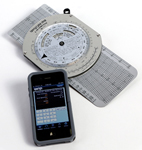This month, we welcome esteemed aviation writer Barry Schiff into the ring. He and Senior Editor Dave Hirschman debate the merits of one of aviation’s finest inventions—the E6B computer.
I want my E6B
Movies dig them, and chicks do too
By Barry Schiff
 The introduction of the digital aviation computer caused widespread belief that the conventional E6B computer would rapidly become an obsolescent relic. But a funny thing happened on the way to the graveyard. The old-fashioned whiz wheel not only survived, it thrived and continues to outsell its microchip counterpart.
The introduction of the digital aviation computer caused widespread belief that the conventional E6B computer would rapidly become an obsolescent relic. But a funny thing happened on the way to the graveyard. The old-fashioned whiz wheel not only survived, it thrived and continues to outsell its microchip counterpart.
One explanation for the continued popularity of the E6B computer is that it is a status symbol. It is cool to have and to brandish. This is similar to when college math, science, and engineering students used to take pride in strutting around campus with slide rules dangling conspicuously from their belts, ready to be quick-drawn like six-shooters from low-slung holsters. Young pups like Dave Hirschman likely never had this pleasure.
I purchased an E6B after my first flying lesson. It’s not that I needed one so early in my flying career—and I certainly didn’t have discretionary income to burn—but I liked the way it looked. It identified me as an aviator. I loved being asked by nonpilots to explain the esoteric E6B “confuser.” The E6B has style, personality. An electronic model looks like any other calculator with a microchip. The E6B also provides us with a sense of history. Just think of all the navigators you have seen using them in war and airline movies while hunched over their charts. Watching them punch in numbers on an electronic calculator at such times would look weird (if not anachronistic).
 Perhaps the most significant reason for the E6B’s longevity and continued popularity is the elegant simplicity with which a pilot can construct a wind triangle, one that is similar to the one that can be plotted on an aeronautical chart. Plotting a wind triangle on an E6B, however, is simpler and requires making only one small pencil mark on the wind side of the computer to represent wind velocity. (For those who don’t have any of those lead-filled, wooden devices, pencils with erasers can still be purchased in five-and-dime stores. Oops. I meant to say, office supply stores.) Once that is done, the pilot simply adjusts the sliding scale to the applicable true airspeed and rotates the compass rose to the desired true course. Voilà! The computer is set up in a way that allows him to “see” the wind triangle and the effect of the wind on his flight. The two unknown quantities, most often groundspeed and drift (added or subtracted from the true course to obtain the true heading) are then read directly from the computer and can be verified intuitively as being reasonably correct solutions to the problem. Electronic computers, on the other hand, are more prone to input errors that produce erroneous errors that we too often presume to be correct—an example of “garbage in, garbage out.”
Perhaps the most significant reason for the E6B’s longevity and continued popularity is the elegant simplicity with which a pilot can construct a wind triangle, one that is similar to the one that can be plotted on an aeronautical chart. Plotting a wind triangle on an E6B, however, is simpler and requires making only one small pencil mark on the wind side of the computer to represent wind velocity. (For those who don’t have any of those lead-filled, wooden devices, pencils with erasers can still be purchased in five-and-dime stores. Oops. I meant to say, office supply stores.) Once that is done, the pilot simply adjusts the sliding scale to the applicable true airspeed and rotates the compass rose to the desired true course. Voilà! The computer is set up in a way that allows him to “see” the wind triangle and the effect of the wind on his flight. The two unknown quantities, most often groundspeed and drift (added or subtracted from the true course to obtain the true heading) are then read directly from the computer and can be verified intuitively as being reasonably correct solutions to the problem. Electronic computers, on the other hand, are more prone to input errors that produce erroneous errors that we too often presume to be correct—an example of “garbage in, garbage out.”
Another E6B benefit is that it will not fail when batteries die, although leaving one on the glareshield on a hot day in direct sunlight can cause it to warp. (My bronze E6B, a collector’s item from World War II, is not so affected but it sure can get hot to the touch.) Speaking of sunlight, this can make LED and LCD displays difficult to read. Although not quite as accurate as an electronic model, the old-fashioned E6B is as accurate as a pilot needs it to be.
In reality, pilots don’t use handheld computers as much these days. Wind-triangle computers of both types are used mostly for training and taking written exams. But for learning the principles of navigation and the effect of the wind, nothing electronic can beat Philip Dalton’s timeless invention, the E6B computer.
Ditch the E6B
You won’t miss it
By Dave Hirschman
 With heartfelt admiration for the genius of E6B creator Phillip Dalton, it’s time to admit that the era of the circular slide rule isn’t just gone, it’s long gone. The whiz wheel that pilots and navigators used to help find their way around the planet since the 1930s was a wonder in its time. But like slide rules and sextants that also were widely used in the same era the E6B was born, those antiquated navigation devices have happily given way to far better ones.
With heartfelt admiration for the genius of E6B creator Phillip Dalton, it’s time to admit that the era of the circular slide rule isn’t just gone, it’s long gone. The whiz wheel that pilots and navigators used to help find their way around the planet since the 1930s was a wonder in its time. But like slide rules and sextants that also were widely used in the same era the E6B was born, those antiquated navigation devices have happily given way to far better ones.
Calculators, fuel computers and totalizers, radio navigation, satellite weather, and GPS have all come into being since the E6B was invented during the first Franklin D. Roosevelt administration, and they all do its jobs (or at least portions of them) better than any crude mechanical instrument ever could. Modern avionics make distance, fuel consumption, and time en route calculations constantly—and in many cases graphically—without requiring number crunching from tired, cranky, distracted, or semi-hypoxic humans.
As a flight student and novice pilot, I’d use an E6B to calculate my airplane’s fuel burn, then round up a little; figure a wind correction angle and estimated groundspeed, then fudge some more. By the time I actually got where I was going, my plans seldom bore more than a passing resemblance to actual reality. These days, an Internet flight planner eliminates such preflight guesswork; a fuel computer constantly updates the rate of fuel consumption, fuel used, and time remaining; XM Weather shows winds aloft and forecasts; and GPS calculates groundspeed five times a second.
When I refill the fuel tanks at my destination, I usually know within a teacup how much they will hold. No technology is infallible, of course, and pilots have been known to enter the wrong waypoints, airport identifiers, fuel quantities, and other erroneous data (don’t ask how I know!). But even E6B aces such as the esteemed Barry Schiff can make mistakes with mechanical flight computers, especially when operating them with one thumb in bumpy cockpits. Fred Noonan, Amelia Earhart’s navigator on their ill-fated around-the-world flight, had an E6B—and he certainly would have gladly traded it for a handheld GPS while searching in vain for Howland Island.
Like Captain Schiff, I got an E6B early in flight training and dutifully carried it through my first decade or so of general aviation flying. But even though it was extremely sturdy and resilient, I never regarded the E6B as a badge of honor. As time went on, I used it less and less until, at some point, I stopped carrying it altogether. And the truth is that I haven’t missed it.
My limited E6B skills have atrophied to the point that, when a student pilot recently asked for help planning a flight with one, I was flummoxed. I’d like to think I could have sat down, read the instructions, and figured it out, but I reflexively took the smartphone path of least resistance. (That “phone,” by the way, has a built-in calculator, compass, internal GPS, AOPA FlyQ app, and it’s a standby attitude indicator, too.)
Student pilots are no longer required to master E6Bs to obtain pilot certificates, and that’s as it should be. Training should resemble real life, and circular slide rules no longer play a meaningful role in most day-to-day flying.
The E6B deserves a prominent and honored place in aviation history, and perhaps museums of technology. But nothing an E6B does can’t be done better, more reliably, and more accurately with other widely available tools.
Email [email protected].



